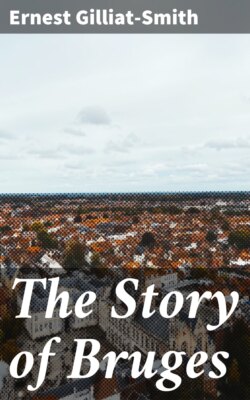Читать книгу The Story of Bruges - Ernest Gilliat-Smith - Страница 9
На сайте Литреса книга снята с продажи.
ОглавлениеTHE CRYPT OF ST. BASIL’S
Clustering around Baldwin’s great fortress were the houses and huts and hovels of such members of the sovereign’s household as were unable to find lodgings within the bourg, of the purveyors who catered for his daily needs, and of a handful of traders and country folk who sought and found safety beneath the shadow of its walls. Even at this early date Bruges must have been a place of some commercial note, for the coins which from time to time have been found in the neighbourhood show that a mint had been already established there in the days of the first Baldwin (865-879), and before the close of his son’s reign, so greatly had the settlement increased, that it was deemed necessary to surround the whole with a moat and a great wall, built up of the veltsteen (field stone) and rubble, which had once been the old bourg (A.D. 912).
Baldwin, Bras de Fer, that redoubtable warrior whom no man had ever seen in the day-time without his coat-of-mail, and who in time of war was said to have not even doffed it at night, had received the County, or, as it was called in those days, Marquisate of Flanders, on terms of defending that quarter of Neustria from the ravages of the Danes, and though with a mighty hand and an outstretched arm, he managed to keep the sea-dogs at bay, his reign of fourteen years was one unbroken hurricane of effort and strife, until he saw the shadow of death on the horizon, and then at last the old soldier sheathed his sword and withdrew to the Abbey of St. Bertin, there in the quiet of its cloister to gather up his strength for the last great battle.
So, too, was it during the days of the second Baldwin, but the mantle of the old Marquis had not fallen on his son. The hard head and iron will and iron hand of Baldwin, Bras de Fer, was not the heritage of Baldwin the Bald, and the wild courage of the Karls of the seaboard, who had to bear the brunt of the battle whilst their panic-stricken chief was safely entrenched in his fortress at Bruges, could do little more than stem the tide. Why dwell on the woes of Neustria, laments Adroald, a monk of Fleury, why dwell on the woes of Neustria? From the shore of the ocean right away to Auvergne there is no country which has preserved its freedom, no city, no village but has been overwhelmed by the devastating fury of these Pagans, and this has been going on for thirty years. Such was the state of affairs at the close of the eight hundreds, and no land on the Continent of Europe had suffered more than Flanders, but though the rural population had been all but wiped out, though hamlet and abbey had gone up in flames, though cities like Courtrai and Arras and Ghent had been pillaged or razed to the ground, somehow or other Bruges had escaped, nay, in spite of the surrounding devastation, perhaps by reason of it, she had prospered, had increased her population, had enlarged her borders, had girded herself, as we have seen, with ramparts, and added to her crown of sanctuaries a new gem.
In the year 880, on the left bank of the Roya, a little higher up stream than the old bourg, the citizens of Bruges built for themselves a chapel, and dedicated it to St. Mary and St. Hilarius—a sufficiently humble structure, knit together like so many churches in the eight hundreds, of rudely-hewn beams and rough planks.
From this grain of mustard seed in after ages there sprang up a tree that is still the glory of Bruges—a stately shrine, adorned by a steeple, than which, in its grand simplicity, there is not one perhaps more lovely in the world.
Baldwin II., who died in the year 918, was buried in the Abbey Church at Blandinium.
The circumstances which led to his interment there are sufficiently curious. They had at first laid him alongside his father at St. Omer, but when his widow Alfrida, who wished to share her lord’s grave, was informed by the abbot of that monastery that his rule forbade him to admit even a dead woman within the precincts of his cloister, she gave orders that Baldwin’s remains should be translated to Blandinium, where they buried him with much solemnity in ædicula Parentis Virginis, and where she herself was laid to rest eleven years later.
THE CHURCH OF NOTRE DAME
